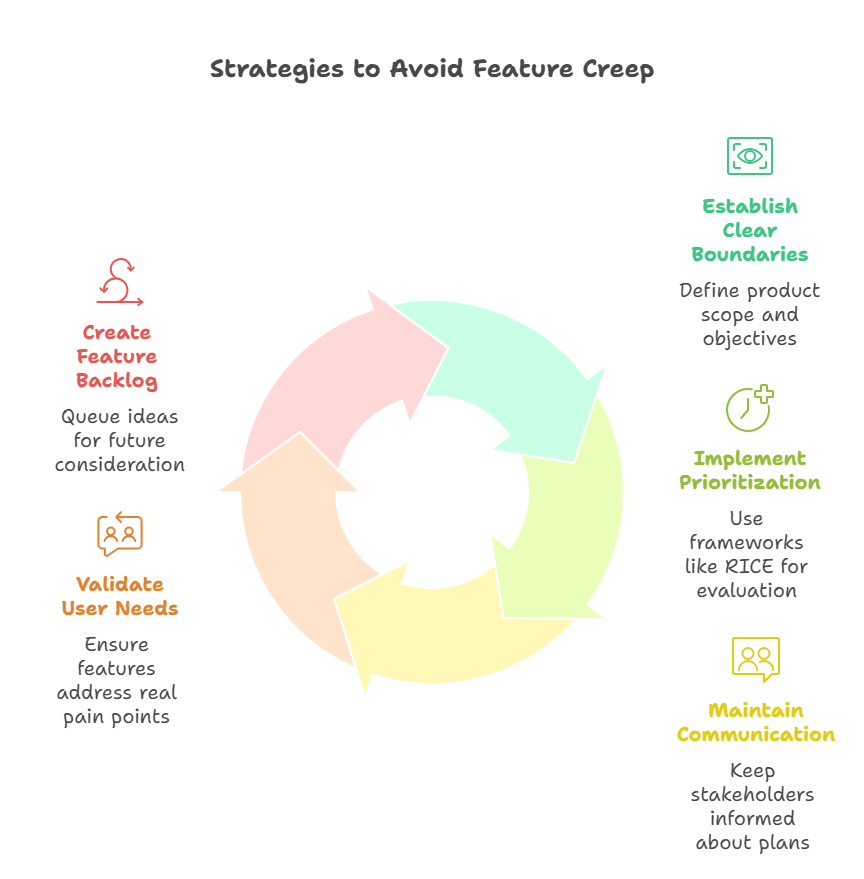What is Feature Creep and How to Avoid It in Product Development
Learn what feature creep is, why it harms product development, and practical strategies to prevent scope creep from derailing your projects and timelines.
What is Feature Creep
Feature creep, also known as scope creep, refers to the gradual addition of excessive features to a product that make it more complicated to use without necessarily adding value. This phenomenon occurs when new features are continuously added to a project beyond its original scope, often without proper evaluation of their necessity or impact.
The slow buildup of unnecessary features can delay product launches and dilute the core focus of what you're trying to build. What starts as a simple, focused product can quickly become bloated with features that complicate the user experience and development process.
Why Feature Creep is Problematic
Feature creep creates predictable negative outcomes across multiple dimensions of product development. Products affected by scope creep typically take longer to develop, cost more, and ultimately fail to meet users' expectations.
The consequences extend beyond just development timelines. According to industry analysis, feature creep leads to project delays, increased costs, and potential customer dissatisfaction. When you keep adding features without proper prioritization, you risk creating a product that tries to do everything but excels at nothing.
Common Causes of Feature Creep
Understanding what drives feature creep is the first step toward preventing it. Several factors contribute to this common product development challenge:
- Lack of clear product vision - Without a well-defined purpose, every new idea seems equally important
- Stakeholder pressure - Different teams and executives pushing for their preferred features
- Competitive anxiety - Adding features because competitors have them, not because users need them
- Poor requirement documentation - Unclear initial specifications leave room for interpretation
- Developer enthusiasm - Team members getting excited about technically interesting but unnecessary features
Practical Strategies to Avoid Feature Creep

Establish Clear Product Boundaries
Your product development process should begin with a well-defined scope that outlines exactly what the product will and won't do. This foundation helps you evaluate every feature request against your core objectives. When considering new features, ask whether they align with your product's primary purpose and user needs.
Implement Rigorous Prioritization
Use frameworks like the RICE scoring method to objectively evaluate feature importance. The RICE framework helps you assess features based on Reach, Impact, Confidence, and Effort, providing a data-driven approach to decision-making.
Maintain Strong Communication Channels
For investor presentations and stakeholder updates, focus on communicating how you plan to prioritize features throughout development. Clear communication about your prioritization strategy helps manage expectations and reduces pressure to add unnecessary features.
Validate Against User Needs
Before adding any feature, validate it against real user pain points. The first step in successful product development is to understand end users' pain points to ensure that core features are linked to user needs and will deliver actual value.
Create a Feature Backlog System
Instead of rejecting good ideas outright, create a structured backlog system. As noted in development communities, creeping features is better than forgetting good ideas, but they should be properly queued for future consideration rather than immediately implemented.
Using Visual Tools to Combat Feature Creep
Visual mapping tools can be incredibly effective for maintaining product focus. Creating a product roadmap mind map helps you visualize how each feature connects to your core objectives and identify when additions are straying from your primary goals.
ClipMind offers powerful visual organization tools that help product teams maintain clarity about what matters most. By mapping out your product strategy visually, you can more easily spot when feature additions are drifting into creep territory.
When to Say No (and How)
Learning to say no to feature requests is a critical skill for product managers. Frame rejections by explaining how the proposed feature doesn't align with current priorities, and suggest adding it to the future consideration list. This approach maintains stakeholder relationships while protecting your product's focus.
Remember that a simple, well-executed product that solves core user problems will always outperform a complex product that tries to do everything. By implementing these strategies, you can deliver products that stay on schedule, within budget, and focused on what truly matters to your users.
 ClipMind
ClipMind